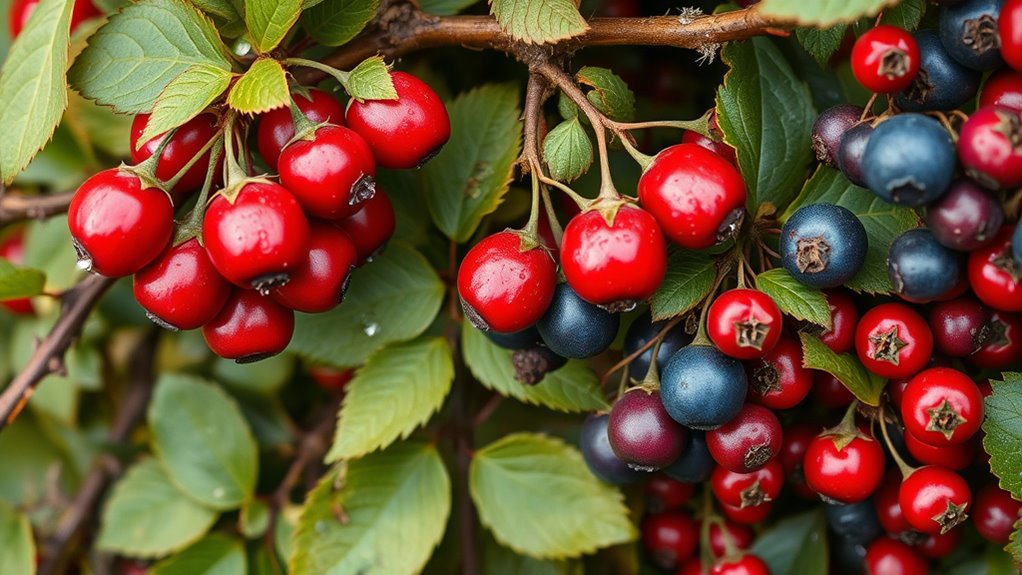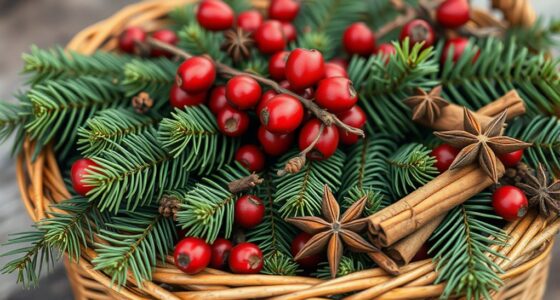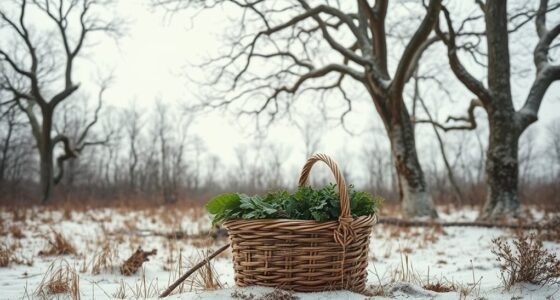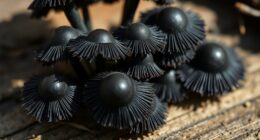In November, your hedgerow offers rich harvests of rosehips, sloes, and hawthorn berries that are essential for wildlife and can be enjoyed by foragers. Look for ripe, vibrant fruits—use scissors or gloves to harvest carefully, leaving enough for animals. These berries are great for making teas, jams, or cordials and help support the local ecosystem. Keep exploring to discover more tips on sustainable foraging and how to connect deeper with nature’s seasonal bounty.
Key Takeaways
- November is ideal for harvesting ripe rosehips, sloes, and hawthorn berries, which provide vital winter food for wildlife.
- Look for fully ripe, vibrantly colored berries that are soft to the touch, indicating optimal harvest time.
- Use careful, sustainable picking methods with gloves to avoid damaging plants and preserve hedgerow health.
- Foraged berries can be used to make teas, jams, or cordials, supporting seasonal culinary traditions.
- Responsible harvesting helps maintain ecosystems, supporting wildlife and the natural resilience of hedgerows during winter.
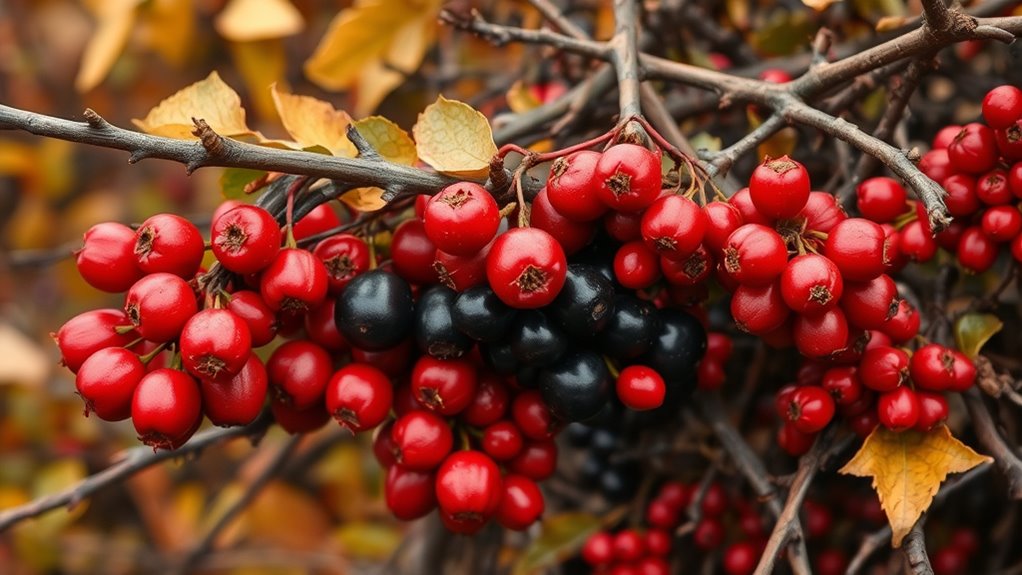
November is the perfect time to explore your hedgerows, as they evolve into a quiet, yet vibrant, winter phase. During this time, you can witness nature’s resilience, as plants and wildlife adapt to the cooler days and shorter nights. As you walk along the tangled branches and dense foliage, you realize that hedgerows are more than just boundaries—they’re essential wildlife habitats, offering shelter, food, and refuge for countless species. This is your chance to connect deeply with the land, to understand how these natural corridors sustain life through the colder months. By observing and foraging thoughtfully, you can tap into the bounty that November offers, all while respecting the balance of the ecosystem.
When exploring, focus on gathering key seasonal treats like rosehips, sloes, and hawthorn berries. These fruits are not only packed with flavor but also serve critical roles for local wildlife. Birds, such as thrushes and blackbirds, flock to these berries, making foraging tips indispensable for those who want to gather responsibly. Take only what you need, and guarantee you leave enough for the birds and other creatures that rely on this natural pantry. Foraging tips include picking fruit that’s fully ripe, with vibrant colors and a soft feel, indicating ripeness and sweetness. Use scissors or your fingers to gently pluck the berries, avoiding damage to the plant. Be cautious of thorns and branches, and wear sturdy gloves to protect your hands.
As you harvest, remember that these berries serve as essential winter food sources for wildlife, helping them build fat reserves and sustain energy during cold months. By gathering with care, you help maintain the health of the hedgerow and its inhabitants. Think of your foraging as a partnership—harvesting what’s needed without stripping the landscape, allowing nature to thrive. This mindful approach transforms a simple walk into a liberating act of stewardship, reconnecting you to the land’s cycles. You’re not just collecting food—you’re supporting the web of life that relies on these plants. Use your foraged bounty to make teas, jams, or cordials, knowing that your efforts honor both the plants and the creatures that depend on them. Incorporating knowledge of local plant properties enhances your understanding and ensures sustainable harvesting practices.
November in the hedgerow isn’t just about observation; it’s a call to action. Embrace your role as a guardian of this critical habitat, learning how to forage tips that respect wildlife and sustain the ecosystem. In doing so, you liberate yourself from the constraints of modern consumption and rediscover the pure joy of living in harmony with nature’s rhythms.
Frequently Asked Questions
When Is the Best Time to Harvest Rosehips Safely?
You should harvest rosehips when they’re ripe, typically after the first frost or in late autumn, as it enhances flavor and sweetness. Timing considerations are key—wait until they turn deep red or orange. Use gentle harvesting techniques—snip the stems carefully to avoid damage. This way, you liberate their full potential, enjoying their vibrant health benefits and rich flavor in your teas and jams, all while respecting the plant’s natural cycle.
Are Sloe Berries Safe to Eat Raw?
You shouldn’t eat sloe berries raw, as they can be toxic and upset your stomach. Think of it like playing with fire—raw sloe berries pose a risk of sloe berry toxicity, which can make you ill. To enjoy their flavor safely, you need to process them through cooking or freezing. Don’t take chances—embrace the freedom of harvesting and preparing sloes properly for a tasty, safe treat.
How Can I Identify Hawthorn in Winter?
You can identify hawthorn in winter by examining its distinctive winter berries, which are bright red and cling tightly to the branches. Look for the thorny branches and the tree’s overall shape, often with a dense, bushy appearance. Tree identification becomes easier with the contrast of the berries against bare branches, and noting the thorny twigs helps you confidently distinguish hawthorn from other winter berries, freeing you to explore hedgerows confidently.
What Tools Are Recommended for Hedgerow Foraging?
Did you know that over 80% of foragers prefer using simple tools? For safe foraging, carry sharp scissors or pruning shears for harvesting techniques that minimize damage to plants. A sturdy pair of gloves protects you from thorns, while a basket keeps your finds secure. These tools empower you to forage freely and responsibly, embracing nature’s bounty while ensuring your safety and preserving the wild harvest for others.
Can I Use Hedgerow Plants for Medicinal Purposes?
Yes, you can use hedgerow plants for medicinal purposes. Many edible wild plants like rosehips, sloe berries, and hawthorn serve as herbal remedies that boost your well-being and connect you with nature’s healing power. Embrace these wild gifts to liberate yourself from synthetic medicines and tap into natural healing. Always guarantee correct identification and consult reliable sources or experts before using hedgerow plants medicinally.
Conclusion
As you explore the hedgerows this November, remember that patience and observation pay off. Collecting rosehips, sloes, and hawthorn can bring you close to nature’s treasures. Keep in mind the saying, “Haste makes waste”—taking your time guarantees you find the best fruits and enjoy the season’s bounty. So, slow down, stay curious, and cherish these quiet moments in the hedgerow’s embrace. Nature rewards those who look carefully and tread lightly.

